QH40A Mod for FT-847
Despite my fan modifications, I was not quite satisfied with the frequency stability on my FT-847, when running high-duty-cycle modes, it would drift up to 3-400Hz on 144MHz after 15-30mins of hard (WSJT, full power) use!
I found a mention of the QH40A Crystal Heater from DB6NT on mods.dk, more information on: http://www.kuhne-electronic.de/english/special/crystalheater.htm , which you place against the appropriate X-tal, to heat it to 40.8° C ±0.1° C
The total price, packaging and postage included (i.e. inside the EU), was € 14.
The heater unit is placed against the Reference X-tal, X1001, and connected to ground and +8-12V
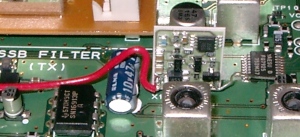
Here the X-tal heater has been placed against X1001 and the wires attached
Jarl, OZ9MO has wrapped a piece of Copper foil around the Crystal before attaching the Crystal heater, in order to improve distribution of the heat to both sides of the crystal. Recommended!
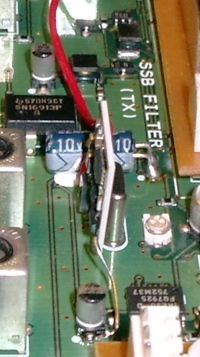
The ground lead soldered to the PCB at a nearby electrolytic Cap. Note the trimmer to the right of the X-tal, this is TC1001, which you need to adjust after the modification is done, to fix the reference oscillator to 45.250MHz ±10Hz! Make a note of the measured frequency on your counter before the modification, and adjust to the same value, after the X-tal has reached its working temperature (3 mins). In this way you compensate for the potential mis-alignment of your counter (but retain any inaccuracy you already had)
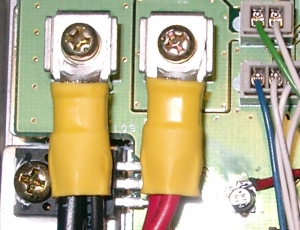
The plus lead goes to the +8V point at the Electrolytic Cap by the 8V regulator at the right hand edge of the FT-847-PCB (lower right-hand corner of picture)
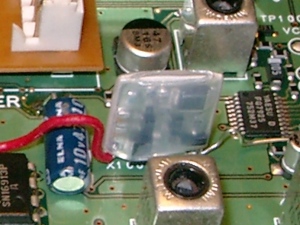
After checking connections, and heat-up of the crystal-heater unit, it is married to X1001 using the supplied heat-shrink tubing.
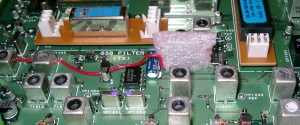
Finally I wrapped the whole assembly in a piece of foam plastic, to further insulate it from external variations. The little round solder blob on the PCB below and right of the crystal heater assembly, marked TP1002, is where you measure the reference frequency. Alternatively you can adjust for correct Xmit frequency ( 430MHz FM-mode!) if you have a power attenuator and an accurate counter.
The end result is very very good, a maximum of ±10Hz drift on 144MHz or < 0.1ppm, after 3 mins warm-up - I don't think it gets much better than this at amateur pricing!
30. november 2005 Update:
A lot of discussions and private feed-back has taken place since this was originally published, an incredible amount of positive reports, but also a few puzzling reports of only partial success. I think it is best summed up by this email from Vladimir, OK1VPZ (published with his permission):
Let me introduce me. I am father of OK1TEH and I am supporting him in the
technical matters. Let me to say a few words about FT847 freq. drift. We
have at home two pieces of FT847, the first we bought in USA in summer of
1998, second from 2002 year production I bought in US as secondhand in
2004 - particularly as basic transceiver for 23cm in our Contest club
station OK2KKW (www.qsl.net/ok2kkw).
The first was always much more unstable, than the second one. Why? Good
question. I tried to compare both oscillators and they were identical
include all components. My guess is, that only one differency could be in
the crystal resonator. Not in quality (albeit some units can be less stable
due to lower Q), but in frequency. Yaesu within production probably
recognized, that original crystals were a little bit lower in frequency and
to adjust them into propper freq. needed lower capacity of variable
capacitor - and then thermal drift of this combination was much larger, than
later on, when crystals began be produced with a little bit higher freq -
what doesn't need so high detuning by variable capacitor to be set on
desired freq. And it resulted with higher stability. Maybe is there even
come combination of positive and negative freq. drift of crystal and trimmer
combination.
Matej used for EME tests on 432 MHz the older and less stable one, because
the newer one was used in that time by OK1RK from our club.
Because of troubles with unstability I bought two heaters from Michael
DB6NT. When I put them into both of FT847 as described by Peter, the first
one became very stable - within aprox.1 min freq is set on adjusted freq -
and then within next 10 sec freq of this one very slowly shifted into lower
freq - aprox by 30 Hz on 432 MHz.
The second one was quite stable before as well as after heater instalation -
drift in both cases was not during 10 min. bigger, than 30 Hertz on 432 MHz
(!). When heater was installed, the second FT847 is very slowly drifting up
(!) cca 20 Hertz in 10 min. That drift in both cases is probably created by
slow thermal drift of trimmer due to step by step heating of it from warm
crystal in the neighbourhood.
So finally I can more less confirm Peter mention, that when crystal is
stabilized, residual thermal drift is created by trimmer capacitor, which is
not only unstable by thermal drift, but on the top as well as unstable from
mechanical reasons. My guess is, that in this case will be even better to
use small trimmer with plastic foil, which has almost zero thermal drift.
But, finally we agreed with Matej, that current stability of the both rigs
would be quite good enough for standard EME operation and we will be focused
in the next future to buy somewhere rubidium freq. standard and then we plan
to lock both of FT847s as well as 23cm and 3cm transverters as "total
solution" :-)
73! Vladimir
ok1vpz
To sum it up: A stability of better than 0.1ppm can be obtained with this rig, and it doesn't get much better than that at any reasonable price, If a modification to allow lock to an external High Precision Frequency Standard can be devised, it'll also be suitable as a back-end for Digital EME down to the millimeter wavelength range.
Further work is needed to ascertain whether an improvement
will result from replacing TC1001(now 20pf) with a smaller value trimmer in
parallel with an NP0 fixed value capacitor, for now I do not recommend
insulating the capacitor as some have done, and I recommend extreme care in
the insulation of the X-tal/Heater Package.